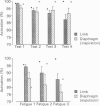Abstract
1. This study used a sensitive modification of the twitch interpolation technique to compare the extent of voluntary neural drive to the diaphragm and the elbow flexors during fatigue. For the diaphragm both inspiratory and expulsive efforts were tested, and fatigue was induced by expulsive efforts which were either maximal voluntary contractions (MVCs, 10 s duration, 50% duty cycle) or submaximal contractions (50% MVC, 3 s duration, 60% duty cycle). 2. Over the series of thirty MVCs peak elbow torque declined to 57.9 +/- 3.0% (mean +/- S.E.M.) of the initial value while maximal inspiratory pressure declined to 78.7 +/- 7.3% (P < 0.05). For the diaphragm the relative decline in voluntary peak inspiratory (and expulsive) force was similar to the decline in twitch responses to single and twin (10 ms interval) stimuli. However, for the elbow flexors the decline in twitch force was disproportionately greater than the decline in maximal voluntary force. The decline in twitch force for the diaphragm could not be attributed to failure at the neuromuscular junction. 3. At the start of the exercise, twitch potentiation (following three brief MVCs) was significantly less for the diaphragm than for the elbow flexors (20% versus 61%, P < 0.01). 4. In the unfatigued state maximal voluntary efforts by subjects activated 98.4 +/- 0.4% of the stimulated elbow flexors compared with 95.0 +/- 1.5% of the diaphragm (P < 0.05). During the exercise period there was a progressive failure in the ability to activate the limb muscle ('central fatigue'; voluntary drive declined from 98.4 +/- 0.4 to 86.8 +/- 2.2%, P < 0.01) whereas the decline in voluntary activation during inspiratory contractions was not significant (from 95.0 +/- 15 to 91.5 +/- 2.5%). 5. Voluntary activation during attempted maximal efforts was less complete for both muscles when stimuli were delivered without warning. The index of voluntary activation for unwarned stimuli was lower for the diaphragm (performing expulsive efforts, 81.0 +/- 2.8%) than for the limb muscle (89.9 +/- 1.5%, P < 0.01). 6. During repeated submaximal expulsive efforts we confirmed that subjects develop a marked inability to contract the diaphragm voluntarily, but when the diaphragm performed inspiratory manoeuvres at the same level of contractile fatigue, the index of voluntary drive was greater than 94%. 7. In conclusion, when tested with inspiratory efforts the diaphragm developed less central fatigue than the limb muscle over the same exercise period.(ABSTRACT TRUNCATED AT 400 WORDS)
Full text
PDF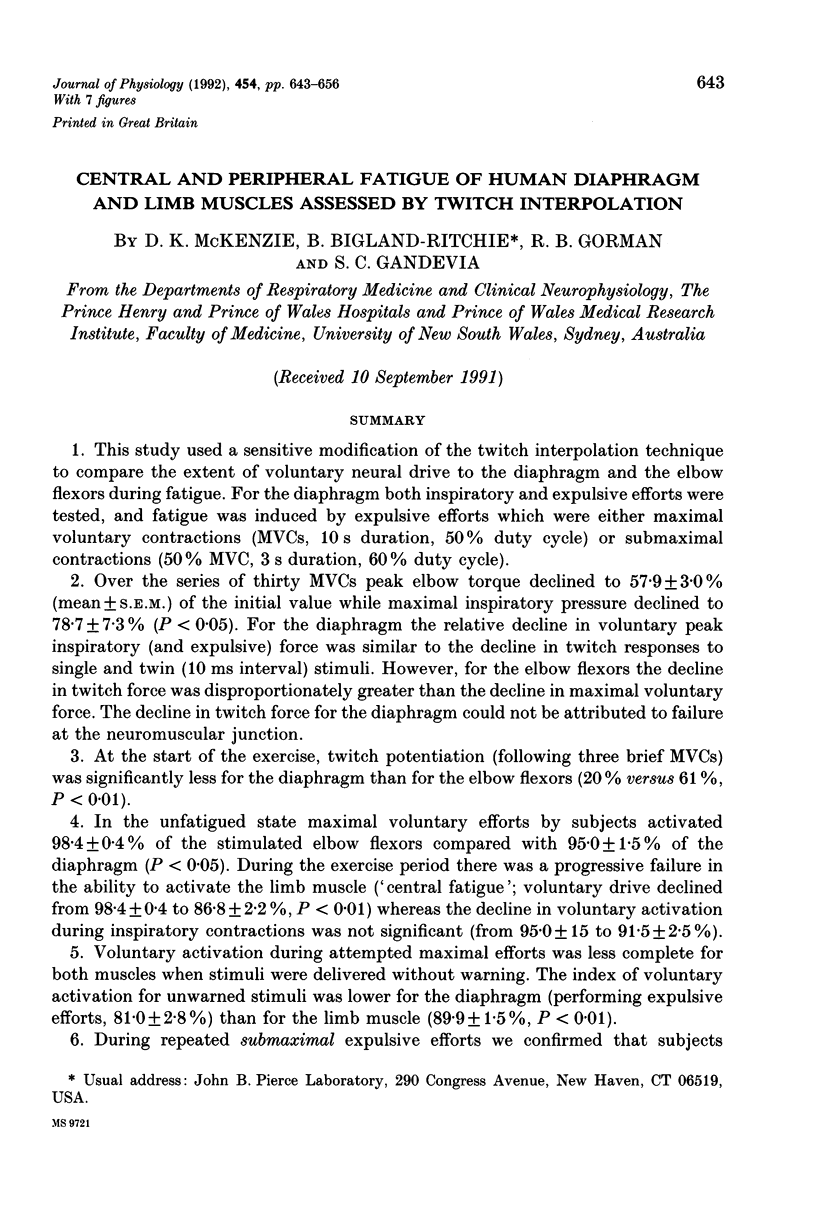
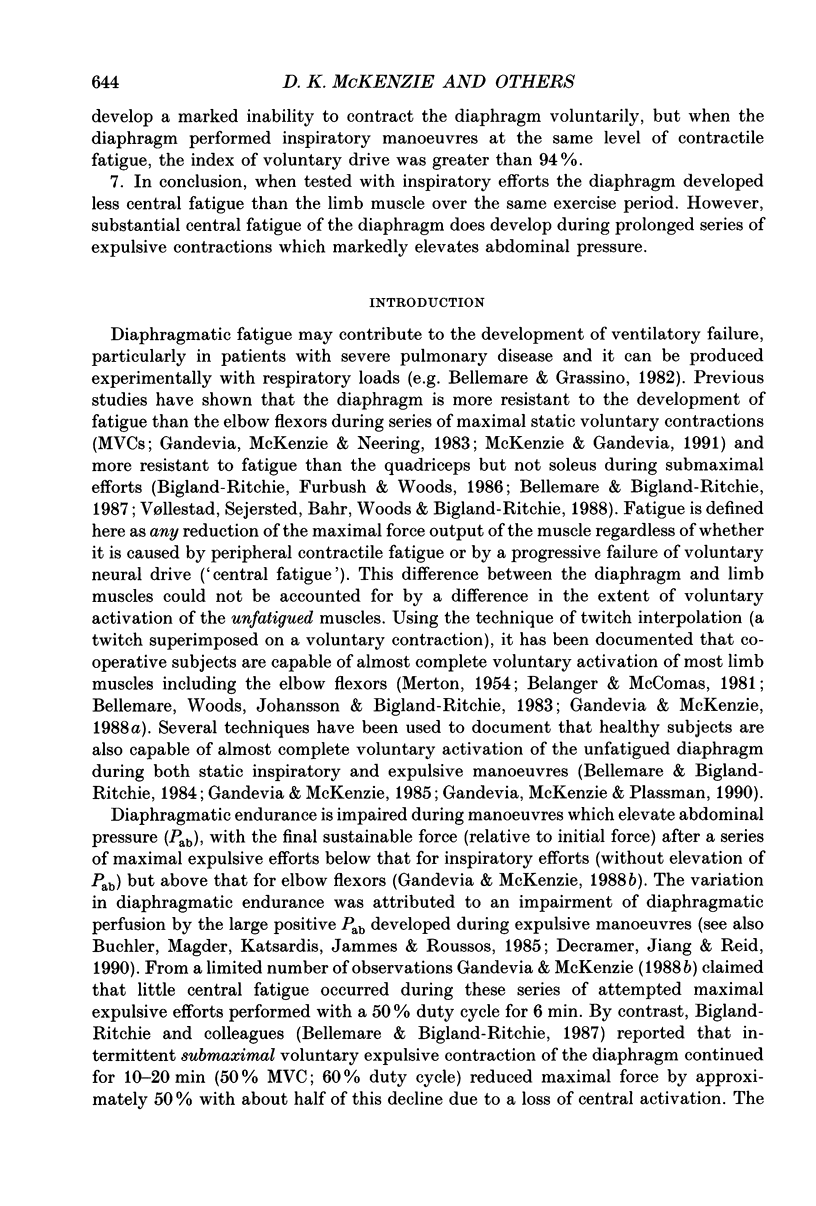

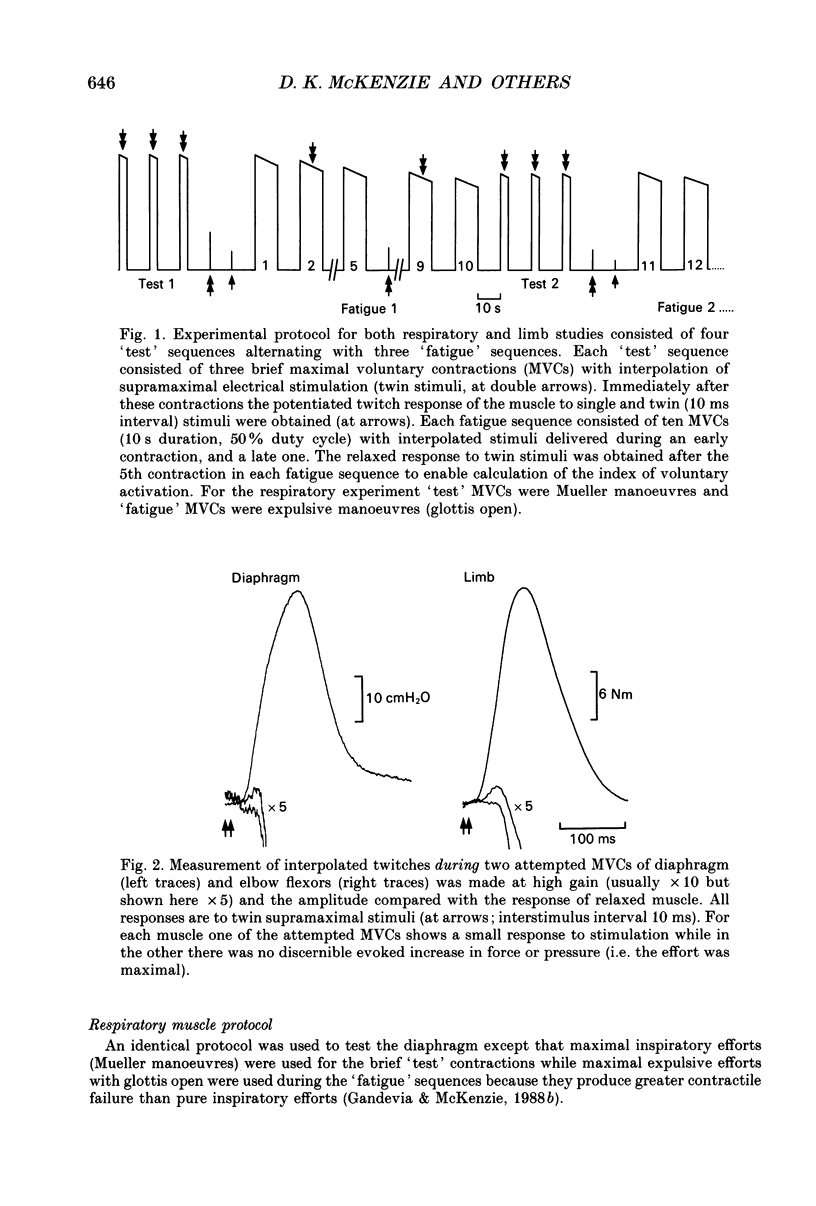

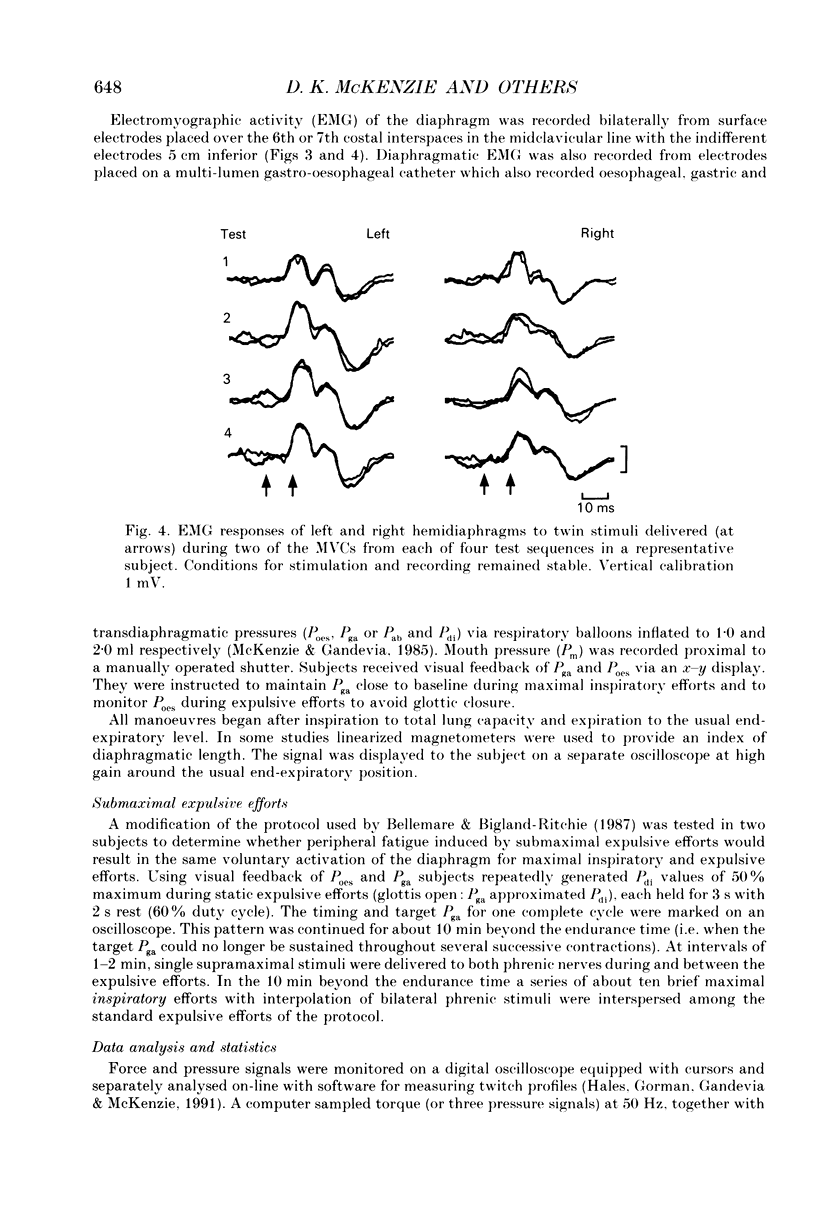
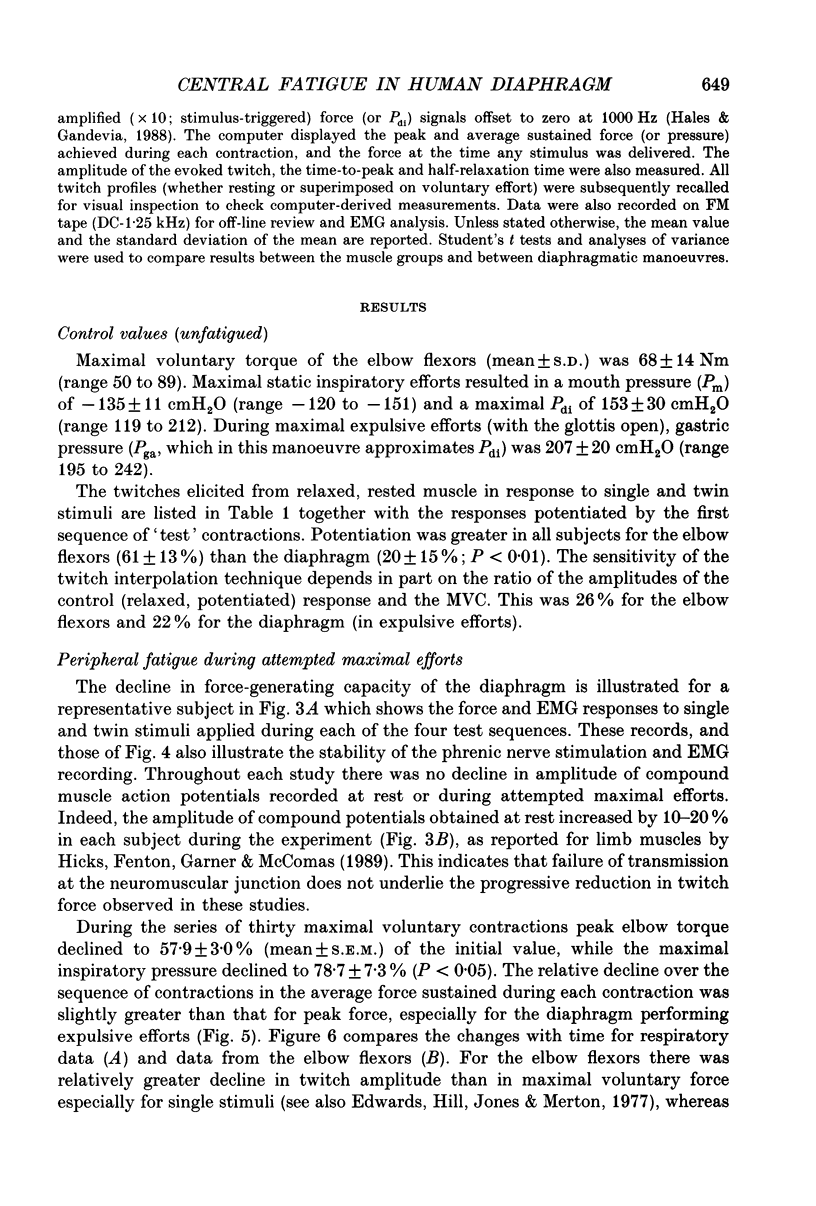
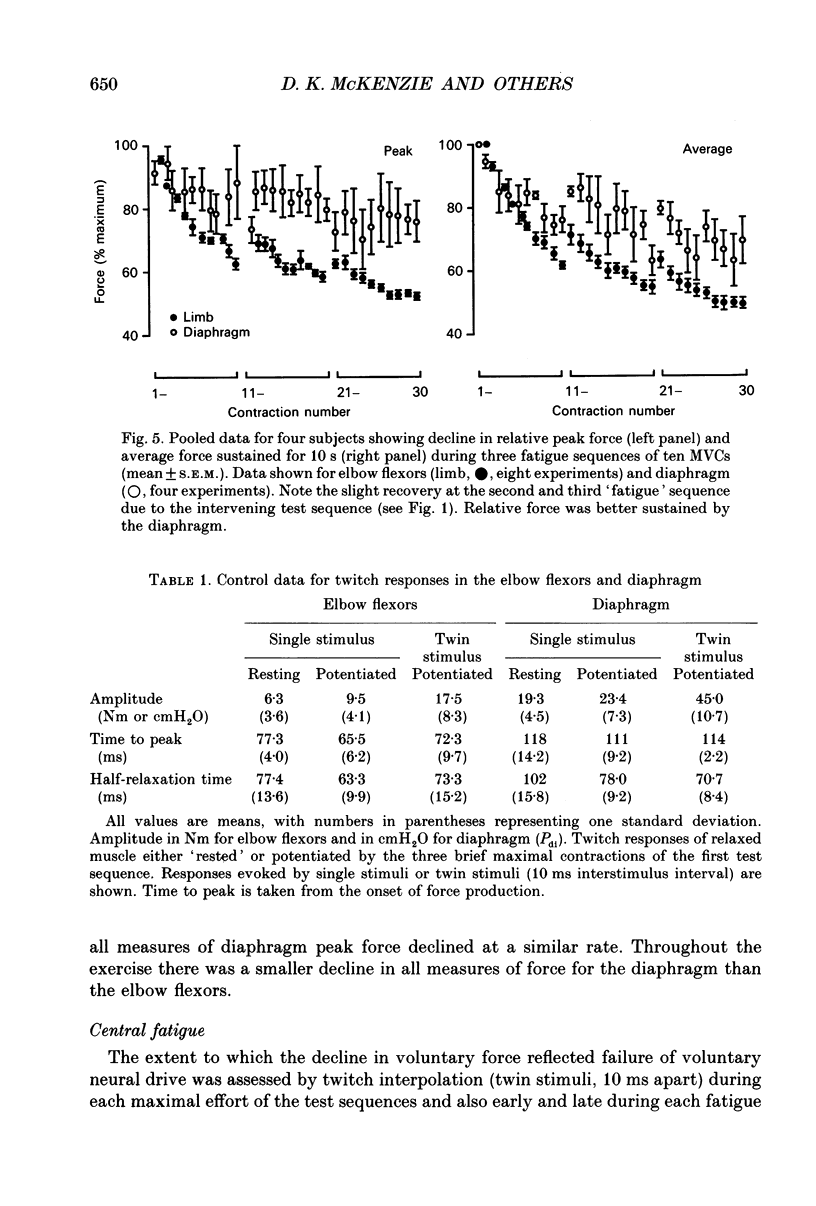
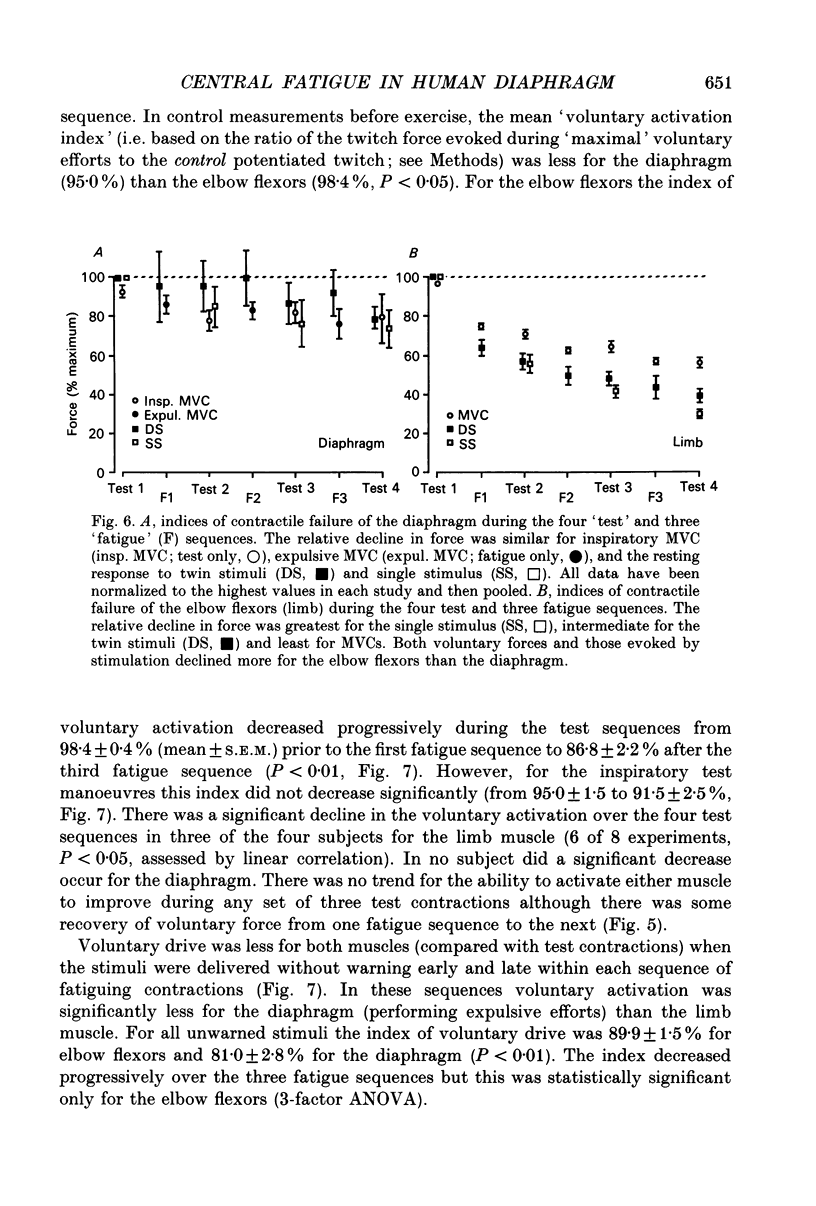
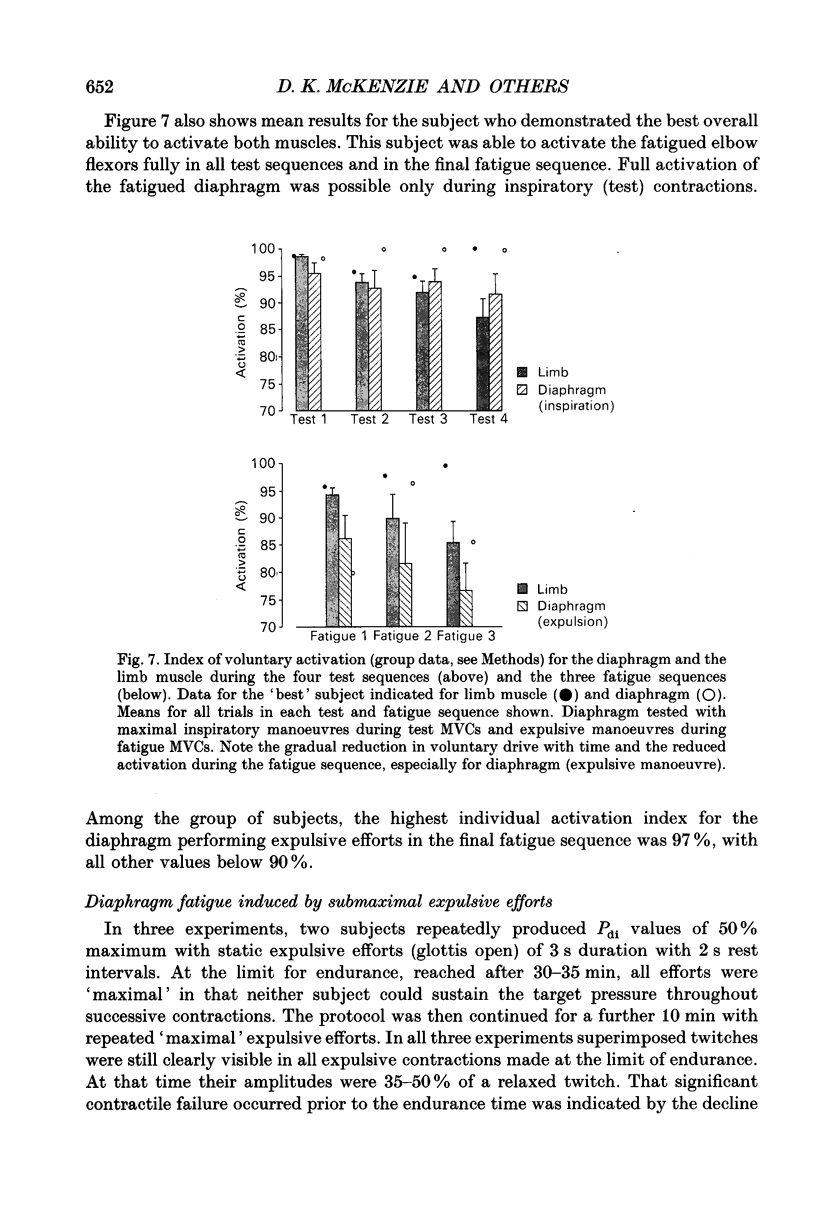
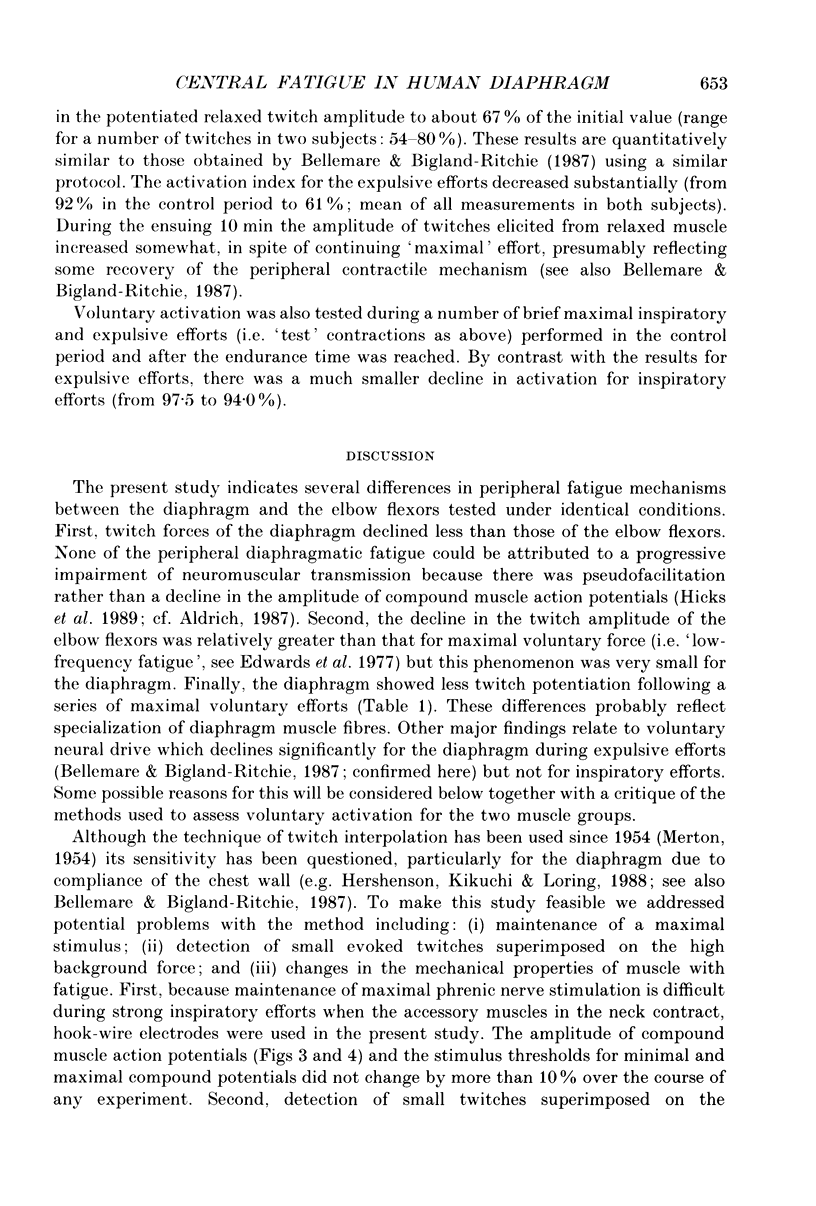



Images in this article
Selected References
These references are in PubMed. This may not be the complete list of references from this article.
- Aldrich T. K. Transmission fatigue of the rabbit diaphragm. Respir Physiol. 1987 Sep;69(3):307–319. doi: 10.1016/0034-5687(87)90085-5. [DOI] [PubMed] [Google Scholar]
- Belanger A. Y., McComas A. J. Extent of motor unit activation during effort. J Appl Physiol Respir Environ Exerc Physiol. 1981 Nov;51(5):1131–1135. doi: 10.1152/jappl.1981.51.5.1131. [DOI] [PubMed] [Google Scholar]
- Bellemare F., Bigland-Ritchie B. Assessment of human diaphragm strength and activation using phrenic nerve stimulation. Respir Physiol. 1984 Dec;58(3):263–277. doi: 10.1016/0034-5687(84)90003-3. [DOI] [PubMed] [Google Scholar]
- Bellemare F., Bigland-Ritchie B. Central components of diaphragmatic fatigue assessed by phrenic nerve stimulation. J Appl Physiol (1985) 1987 Mar;62(3):1307–1316. doi: 10.1152/jappl.1987.62.3.1307. [DOI] [PubMed] [Google Scholar]
- Bellemare F., Grassino A. Effect of pressure and timing of contraction on human diaphragm fatigue. J Appl Physiol Respir Environ Exerc Physiol. 1982 Nov;53(5):1190–1195. doi: 10.1152/jappl.1982.53.5.1190. [DOI] [PubMed] [Google Scholar]
- Bellemare F., Woods J. J., Johansson R., Bigland-Ritchie B. Motor-unit discharge rates in maximal voluntary contractions of three human muscles. J Neurophysiol. 1983 Dec;50(6):1380–1392. doi: 10.1152/jn.1983.50.6.1380. [DOI] [PubMed] [Google Scholar]
- Bigland-Ritchie B., Furbush F., Woods J. J. Fatigue of intermittent submaximal voluntary contractions: central and peripheral factors. J Appl Physiol (1985) 1986 Aug;61(2):421–429. doi: 10.1152/jappl.1986.61.2.421. [DOI] [PubMed] [Google Scholar]
- Buchler B., Magder S., Katsardis H., Jammes Y., Roussos C. Effects of pleural pressure and abdominal pressure on diaphragmatic blood flow. J Appl Physiol (1985) 1985 Mar;58(3):691–697. doi: 10.1152/jappl.1985.58.3.691. [DOI] [PubMed] [Google Scholar]
- Decramer M., Jiang T. X., Reid M. B. Respiratory changes in diaphragmatic intramuscular pressure. J Appl Physiol (1985) 1990 Jan;68(1):35–43. doi: 10.1152/jappl.1990.68.1.35. [DOI] [PubMed] [Google Scholar]
- Edwards R. H., Hill D. K., Jones D. A., Merton P. A. Fatigue of long duration in human skeletal muscle after exercise. J Physiol. 1977 Nov;272(3):769–778. doi: 10.1113/jphysiol.1977.sp012072. [DOI] [PMC free article] [PubMed] [Google Scholar]
- Gandevia S. C., McKenzie D. K. Activation of human muscles at short muscle lengths during maximal static efforts. J Physiol. 1988 Dec;407:599–613. doi: 10.1113/jphysiol.1988.sp017434. [DOI] [PMC free article] [PubMed] [Google Scholar]
- Gandevia S. C., McKenzie D. K. Activation of the human diaphragm during maximal static efforts. J Physiol. 1985 Oct;367:45–56. doi: 10.1113/jphysiol.1985.sp015813. [DOI] [PMC free article] [PubMed] [Google Scholar]
- Gandevia S. C., McKenzie D. K. Human diaphragmatic endurance during different maximal respiratory efforts. J Physiol. 1988 Jan;395:625–638. doi: 10.1113/jphysiol.1988.sp016938. [DOI] [PMC free article] [PubMed] [Google Scholar]
- Gandevia S. C., McKenzie D. K., Neering I. R. Endurance properties of respiratory and limb muscles. Respir Physiol. 1983 Jul;53(1):47–61. doi: 10.1016/0034-5687(83)90015-4. [DOI] [PubMed] [Google Scholar]
- Gandevia S. C., McKenzie D. K., Plassman B. L. Activation of human respiratory muscles during different voluntary manoeuvres. J Physiol. 1990 Sep;428:387–403. doi: 10.1113/jphysiol.1990.sp018218. [DOI] [PMC free article] [PubMed] [Google Scholar]
- Hershenson M. B., Kikuchi Y., Loring S. H. Relative strengths of the chest wall muscles. J Appl Physiol (1985) 1988 Aug;65(2):852–862. doi: 10.1152/jappl.1988.65.2.852. [DOI] [PubMed] [Google Scholar]
- Hicks A., Fenton J., Garner S., McComas A. J. M wave potentiation during and after muscle activity. J Appl Physiol (1985) 1989 Jun;66(6):2606–2610. doi: 10.1152/jappl.1989.66.6.2606. [DOI] [PubMed] [Google Scholar]
- Hubmayr R. D., Litchy W. J., Gay P. C., Nelson S. B. Transdiaphragmatic twitch pressure. Effects of lung volume and chest wall shape. Am Rev Respir Dis. 1989 Mar;139(3):647–652. doi: 10.1164/ajrccm/139.3.647. [DOI] [PubMed] [Google Scholar]
- Lloyd A. R., Gandevia S. C., Hales J. P. Muscle performance, voluntary activation, twitch properties and perceived effort in normal subjects and patients with the chronic fatigue syndrome. Brain. 1991 Feb;114(Pt 1A):85–98. [PubMed] [Google Scholar]
- MERTON P. A. Voluntary strength and fatigue. J Physiol. 1954 Mar 29;123(3):553–564. doi: 10.1113/jphysiol.1954.sp005070. [DOI] [PMC free article] [PubMed] [Google Scholar]
- McKenzie D. K., Gandevia S. C. Phrenic nerve conduction times and twitch pressures of the human diaphragm. J Appl Physiol (1985) 1985 May;58(5):1496–1504. doi: 10.1152/jappl.1985.58.5.1496. [DOI] [PubMed] [Google Scholar]
- McKenzie D. K., Gandevia S. C. Recovery from fatigue of human diaphragm and limb muscles. Respir Physiol. 1991 Apr;84(1):49–60. doi: 10.1016/0034-5687(91)90018-e. [DOI] [PubMed] [Google Scholar]
- Thomas C. K., Woods J. J., Bigland-Ritchie B. Impulse propagation and muscle activation in long maximal voluntary contractions. J Appl Physiol (1985) 1989 Nov;67(5):1835–1842. doi: 10.1152/jappl.1989.67.5.1835. [DOI] [PubMed] [Google Scholar]
- Vøllestad N. K., Sejersted O. M., Bahr R., Woods J. J., Bigland-Ritchie B. Motor drive and metabolic responses during repeated submaximal contractions in humans. J Appl Physiol (1985) 1988 Apr;64(4):1421–1427. doi: 10.1152/jappl.1988.64.4.1421. [DOI] [PubMed] [Google Scholar]



